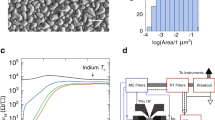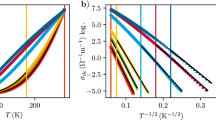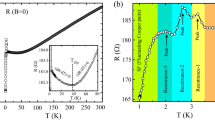Abstract
Granular conductors1 are solids comprising densely packed nanoparticles, and have electrical properties that are determined by the size, composition and packing of the composite nanoparticles. The ability to control these properties in two- and three-dimensional granular conductors has made such systems appropriate for use as prototypes for investigating new physics1,2,3,4. However, the fabrication of strictly one-dimensional granular conductors remains challenging. Here, we describe a method for the assembly of nanoparticles into granular solids that can be tuned continuously from two to one dimension, and establish how electron transport evolves between these limits. We find that the energy barriers to transport increase in the one-dimensional limit, in both the variable-range-hopping (low-voltage) and sequential-tunnelling (high-voltage) regimes. Furthermore, in the sequential-tunnelling regime we find an unexpected relationship between the temperature and the voltage at which the conductance becomes appreciable — a relationship that appears peculiar to one-dimensional systems. These results are explained by extrapolating existing granular conductor theories to one dimension.
This is a preview of subscription content, access via your institution
Access options
Subscribe to this journal
Receive 12 print issues and online access
$259.00 per year
only $21.58 per issue
Buy this article
- Purchase on Springer Link
- Instant access to full article PDF
Prices may be subject to local taxes which are calculated during checkout




Similar content being viewed by others
References
Beloborodov, I. S., Lopatin, A. V., Vinokur, V. M. & Efetov, K. B. Granular electronic systems. Rev. Mod. Phys. 79, 469–518 (2007).
Murray, C. B., Kagan, C. R. & Bawendi, M. G. Synthesis and characterization of monodisperse nanocrystals and close-packed nanocrystal assemblies. Ann. Rev. Mater. Sci. 30, 545–610 (2000).
Markovich, G. et al. Architectonic quantum dot solids. Acc. Chem. Res. 32, 415–423 (1999).
Fan, H. Y. et al. Self-assembly of ordered, robust, three-dimensional gold nanocrystal/silica arrays. Science 304, 567–571 (2004).
Bawendi, M. G., Steigerwald, M. L. & Brus, L. E. The quantum mechanics of larger semiconductor clusters (quantum dots). Ann. Rev. Phys. Chem. 41, 477–496 (1990).
Alivisatos, A. P. Semiconductor clusters, nanocrystals and quantum dots. Science 271, 933–937 (1996).
Xia, Y. N. et al. One-dimensional nanostructures: Synthesis, characterization and applications. Adv. Mater. 15, 353–389 (2003).
Remacle, F. & Levine, R. D. Quantum dots as chemical building blocks: Elementary theoretical considerations. ChemPhysChem 2, 20–36 (2001).
Chung, S. W., Markovich, G. & Heath, J. R. Fabrication and alignment of wires in two dimensions. J. Phys. Chem. B 102, 6685–6687 (1998).
Bezryadin, A., Westervelt, R. M. & Tinkham, M. Self-assembled chains of graphitized carbon nanoparticles. Appl. Phys. Lett. 74, 2699–2701 (1999).
Elteto, K., Lin, X. M. & Jaeger, H. M. Electronic transport in quasi-one-dimensional arrays of gold nanocrystals. Phys. Rev. B 71, 205412 (2005).
Tang, Z. Y. & Kotov, N. A. One-dimensional assemblies of nanoparticles: Preparation, properties, and promise. Adv. Mater. 17, 951–962 (2005).
Huang, J. X., Tao, A. R., Connor, S., He, R. R. & Yang, P. D. A general method for assembling single colloidal particle lines. Nano Lett. 6, 524–529 (2006).
DeVries, G. A. et al. Divalent metal nanoparticles. Science 315, 358–361 (2007).
Xia, Y. N., Yin, Y. D., Lu, Y. & McLellan, J. Template-assisted self-assembly of spherical colloids into complex and controllable structures. Adv. Funct. Mater. 13, 907–918 (2003).
Cui, Y. et al. Integration of colloidal nanocrystals into lithographically patterned devices. Nano Lett. 4, 1093–1098 (2004).
Kraus, T. et al. Nanoparticle printing with single-particle resolution. Nature Nanotech. 2, 570–576 (2007).
Melosh, N. A. et al. Ultrahigh-density nanowire lattices and circuits. Science 300, 112–115 (2003).
Zeng, H. et al. Magnetotransport of magnetite nanoparticle arrays. Phys. Rev. B 73, 020402 (2006).
Yakimov, A. I. et al. Long-range Coulomb interaction in arrays of self-assembled quantum dots. Phys. Rev. B 61, 10868–10876 (2000).
Beverly, K. C., Sampaio, J. F. & Heath, J. R. Effects of size dispersion disorder on the charge transport in self-assembled 2-D Ag nanoparticle arrays. J. Phys. Chem. B 106, 2131–2135 (2002).
Yu, D., Wang, C. J., Wehrenberg, B. L. & Guyot-Sionnest, P. Variable range hopping conduction in semiconductor nanocrystal solids. Phys. Rev. Lett. 92, 216802 (2004).
Zabet-Khosousi, A. & Dhirani, A. A. Charge transport in nanoparticle assemblies. Chem. Rev. 108, 4072–4124 (2008).
Shklovskii, B. I. & Efros, A. L. in Electronic Properties of Doped Semiconductors (Springer, 1984).
Remacle, F., Beverly, K. C., Heath, J. R. & Levine, R. D. Conductivity of 2-D Ag quantum dot arrays: Computational study of the role of size and packing disorder at low temperatures. J. Phys. Chem. B 106, 4116–4126 (2002).
Levin, E. I., Nguen, V. L., Shklovskii, B. I. & Efros, A. L. Coulomb gap and hopping electric conduction. Computer simulation. Sov. Phys. JETP 65, 842–848 (1987).
Nguyen, V. D., Nguyen, V. L. & Dang, D. T. Variable range hopping in the Coulomb gap and gate screening in two dimensions. Phys. Lett. A 349, 404–410 (2006).
Ancona, M. G. et al. Coulomb blockade in single-layer Au nanocluster films. Phys. Rev. B 64, 033408 (2001).
Parthasarathy, R., Lin, X. M., Elteto, K., Rosenbaum, T. F. & Jaeger, H. M. Percolating through networks of random thresholds: Finite temperature electron tunneling in metal nanocrystal arrays. Phys. Rev. Lett. 92, 076801 (2004).
Middleton, A. A. & Wingreen, N. S. Collective transport in arrays of small metallic dots. Phys. Rev. Lett. 71, 3198–3201 (1993).
Elteto, K., Antonyan, E. G., Nguyen, T. T. & Jaeger, H. M. Model for the onset of transport in systems with distributed thresholds for conduction. Phys. Rev. B 71, 064206 (2005).
Reichhardt, C. & Reichhardt, C. J. O. Temperature and a.c. effects on charge transport in arrays of metallic dots. Phys. Rev. B 68, 165305 (2003).
Acknowledgements
The authors would like to thank Peigen Cao and Yue Zou (Caltech) for helpful discussions and Xingchen Ye and C. B. Murray (University of Pennsylvania) for providing the gold quantum dots. This work was supported by the Department of Energy, the National Science Foundation, and the MARCO Center for Advanced Materials and Devices.
Author information
Authors and Affiliations
Corresponding author
Supplementary information
Supplementary information
Supplementary information (PDF 1170 kb)
Rights and permissions
About this article
Cite this article
Xu, K., Qin, L. & Heath, J. The crossover from two dimensions to one dimension in granular electronic materials. Nature Nanotech 4, 368–372 (2009). https://doi.org/10.1038/nnano.2009.81
Received:
Accepted:
Published:
Issue Date:
DOI: https://doi.org/10.1038/nnano.2009.81
This article is cited by
-
An ultrahigh resolution pressure sensor based on percolative metal nanoparticle arrays
Nature Communications (2019)
-
Formation of printable granular and colloidal chains through capillary effects and dielectrophoresis
Nature Communications (2017)
-
Stress Wave Propagation in Two-dimensional Buckyball Lattice
Scientific Reports (2016)
-
Gold nanoparticle assemblies stabilized by bis(phthalocyaninato)lanthanide(III) complexes through van der Waals interactions
Scientific Reports (2014)
-
Dimensionality-dependent charge transport in close-packed nanoparticle arrays: from 2D to 3D
Scientific Reports (2014)



